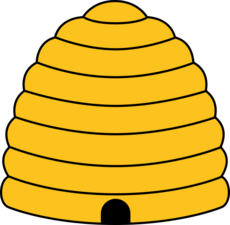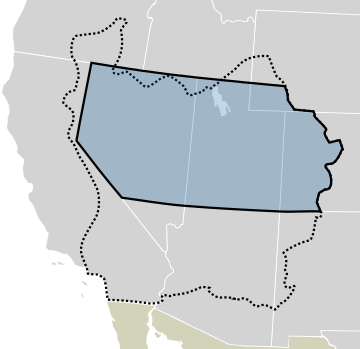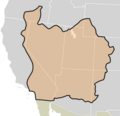State of Deseret facts for kids
Quick facts for kids
State of Deseret
|
|||||||||
|---|---|---|---|---|---|---|---|---|---|
| 1849–1850, Utah War | |||||||||
|
Flags of the State of Deseret
|
|||||||||
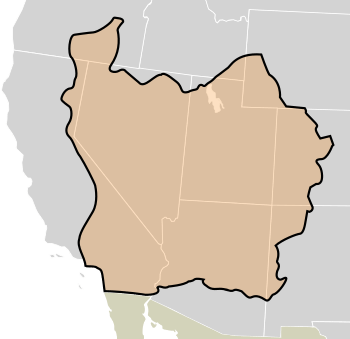
The boundaries of the provisional State of Deseret (orange with black outline) as proposed in 1849. Modern state boundaries are underlaid for reference.
|
|||||||||
| Status | Unrecognized state | ||||||||
| Capital | Great Salt Lake City | ||||||||
| Common languages | English | ||||||||
| Religion | The Church of Jesus Christ of Latter-day Saints | ||||||||
| Government | Theodemocracy | ||||||||
| Governor | |||||||||
|
• 1849–1850
|
Brigham Young | ||||||||
| History | |||||||||
|
• Established
|
1849 | ||||||||
|
• Disestablished
|
1850, Utah War | ||||||||
|
|||||||||
| Today part of | United States | ||||||||
The State of Deseret was a proposed state in the United States. It was suggested in 1849 by settlers from The Church of Jesus Christ of Latter-day Saints (often called the LDS Church). These settlers lived in Salt Lake City. This proposed state lasted for just over two years. However, the United States government never officially recognized it. The name "Deseret" comes from a word in the Book of Mormon that means "honeybee."
Contents
History of Deseret
How the Idea for Deseret Started
In 1847, members of the LDS Church, known as Mormon pioneers, settled in the Salt Lake Valley near the Great Salt Lake. At that time, this area was part of Mexico. The settlers wanted to create a government that the United States would recognize.
At first, Brigham Young, who was the president of the LDS Church, planned to ask for the area to become a U.S. territory. He sent John Milton Bernhisel to Washington, D.C. with this request. But then, Young learned that California and New Mexico were asking to become states. So, he changed his mind and decided to ask for statehood instead.
In March 1849, Young and other church leaders realized they didn't have much time. They quickly wrote a state constitution. They based it on the constitution of Iowa, where many Mormons had lived before. Since there was no printing press in the Great Basin area, they sent the documents to Iowa to be printed. They then sent a second messenger to Washington, D.C. This messenger was to meet Bernhisel and ask for Deseret to become a state, not just a territory.
The Proposed Territory of Deseret
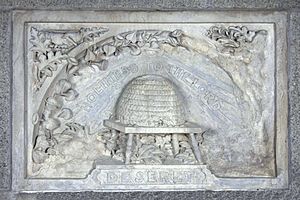
The proposed State of Deseret would have covered a huge area. This land had been gained from Mexico the year before, in what was called the Mexican Cession.
The Territory of Deseret would have included most of the land between the Sierra Nevada mountains and the Rocky Mountains. It would have stretched from the border with Mexico north into parts of the Oregon Territory. It also included the California coast south of the Santa Monica Mountains, like Los Angeles and San Diego. This vast area included almost all of the Colorado River watershed and the entire Great Basin.
The proposal covered nearly all of present-day Utah and Nevada. It also included large parts of California and Arizona, plus some areas of Colorado, New Mexico, Wyoming, Idaho, and Oregon.
The leaders carefully planned the borders to avoid problems with existing settlements. At the time, there weren't many European-American settlers in the Deseret area, except for the northern California gold rush regions, which were not part of the proposed state. The border with New Mexico was set to avoid conflicts over the western border of Texas. Deseret also avoided the fertile Willamette Valley in Oregon, which had many settlers.
Also, much of the proposed land was known to be difficult for farming. This helped avoid arguments about whether slavery should be allowed in new states.
Some people in the United States Congress thought the idea for Deseret was too big to succeed. This was even before considering the controversy over the Mormon practice of plural marriage (polygamy). However, in 1849, U.S. President Zachary Taylor wanted to avoid arguments. He sent his agent, John Wilson, west with an idea to combine California and Deseret into one large state. This would have meant fewer new free states joining the Union. This could help keep the balance of power in the United States Senate between states that allowed slavery and those that did not.
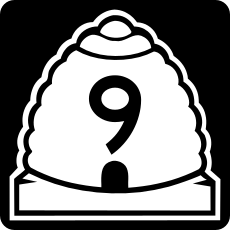
During the California Constitutional Conventions in 1849, the Mormons and Salt Lake were often mentioned. There were debates about the North-South conflict over slavery. Some people wanted smaller borders for California. They argued that the Mormons were not at the convention, had different customs, and wanted their own government. They also said Salt Lake was too far away for one government to work well. They believed Congress would not agree to such a huge state. Others, like future Senator William M. Gwin, who supported slavery, argued these problems were not serious or could be fixed later.
The Creation of Utah Territory
On September 9, 1850, as part of the Compromise of 1850, the Utah Territory was created by an Act of Congress. This new territory included a part of the northern section of what Deseret had proposed.
On February 3, 1851, Brigham Young became the first governor of the Utah Territory. On April 4, 1851, the General Assembly of Deseret voted to officially end the State of Deseret. However, on October 4, 1851, the Utah territorial legislature voted to use the laws and rules that the State of Deseret had created.
Even after the Utah Territory was formed, the Latter-day Saints did not give up on the idea of a "State of Deseret." From 1862 to 1870, a group of Mormon elders, led by Brigham Young, met secretly. After each session of the territorial legislature, they would meet to approve the new laws under the name of the "State of Deseret." They tried to write a new state constitution under that name in 1856, 1862, and 1872. These new constitutions were based on the updated borders of the Utah Territory.
The idea of a state based on Mormonism began to fade. This happened after the railroad arrived, bringing many non-Mormon settlers to the territory, especially in the western areas. Young and the LDS Church supported the railroad. They even moved members who were working on the Salt Lake Temple to help build the railroad. The golden spike was driven just 66 miles from Salt Lake in 1869. This completed the first transcontinental railroad at Promontory Summit.
Government of Deseret
Before the Utah Territory was officially set up, the provisional government of Deseret acted as the real government for the Great Basin area. Three sessions of the General Assembly were held. This was a bicameral (two-house) state legislature. In 1850, the legislature appointed judges and created a set of criminal laws. They also set up property taxes. Alcohol and gambling were made illegal. The LDS Church was officially recognized as a corporation. A militia, called the Nauvoo Legion, was also formed.
The legislature first created six counties. These "valley counties" only covered the areas where people lived. As more settlers arrived, these counties were expanded to cover more of the Deseret area.
Flag of Deseret
Most descriptions say the Deseret flag looked similar to the current Utah state flag. However, there was no official standard for the flag. So, other flags, both non-religious and religious, were also used. Some flags that looked like the U.S. Flag were also reported.
-
Reconstruction of the flag described by Don Maguire in 1877, used by Mormon pioneers
Images for kids
See also
 In Spanish: Estado de Deseret para niños
In Spanish: Estado de Deseret para niños



